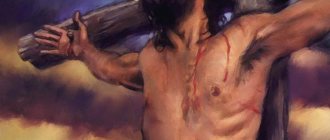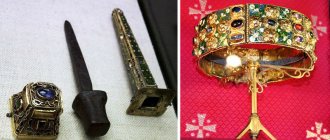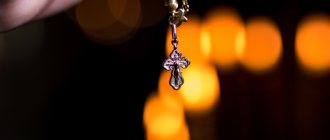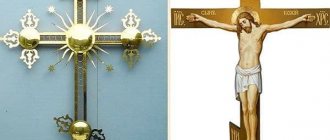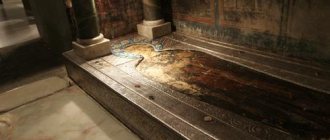The cross is the oldest universal symbol of mankind; it received special meaning in Christianity as an instrument for the murder of Christ; it signifies the sacrificial love of God for fallen people. Crucified on the cross, Jesus accepted martyrdom to atone for human sins. In Christian cemeteries, the burial place is marked by a grave cross. He is a symbol of eternal life.
How the symbol of the cross came to be
This sign dates back to pre-Christian times. Thus, the ancient Egyptians used a cross with a ring to depict life and gods, the Babylonians - the god of heaven, the Assyrians - the god of the Sun.
In Europe, the Middle East, America - everywhere, pagans used the image of a cross (a geometric figure, most often consisting of lines crossed at an angle of 90°) to depict natural forces. Even idolaters put a sacred meaning into it, calling it a symbol of new life; the same meaning was later used by Christians.
Answers to popular questions
Despite the antiquity of the tradition, questions about wearing a symbol of faith arise even among believers.
The need for consecration in the temple
As noted, the power of the cross is determined by a person’s faith. But still, it is better to consecrate the product.
What to do in case of loss
If lost, you must purchase a new cross. Christians attach a negative meaning to such an incident. But prayer and purchasing a new product will help correct the situation.
What to do with a found cross
It’s better not to pick up the find. But if you still find it in your hands, then you need to take it to the temple. There it will be consecrated and given to those in need.
Is it possible to give
You can give the product as a gift, but only to family and friends with a sincere desire to help. Believers say that by giving a cross, you also give a part of your well-being.
How to consecrate
Only the priest in the church can consecrate the product. If this is not possible, then the Lord’s Prayer is read over the cross and then worn around the neck.
Two crosses
The Church does not prohibit having two creeds. But usually an icon is chosen as the second one. One product can be placed above the head of the bed, or near icons, and the second can be worn as a body item. .
Cross as a religious symbol
The Christian cross, along with icons, is an object of worship among Catholics and Orthodox Christians. The veneration of the Great Sign goes back to the history of the execution of the God-Man, sent by the Father to earth, and who accepted a shameful (criminals were crucified on the cross) and painful death on the cross. This act brought spiritual benefit to humanity. Other ideas of Christianity originate from the atoning death of Christ: the sanctification of believers, various sacraments, the theme of suffering and virtue, the Last Judgment, and in general the meaning of life and death.
Christians receive a cross at baptism (most often in infancy), and must wear it throughout their lives as a symbol of faith. After the death of a person, a cross is placed in the coffin, a crucifix is placed in the hands, and a cross is placed on the lid of the coffin. At the grave, clergy advise placing not an expensive monument made of granite or marble, even with a Christian symbol carved on it, but an ordinary wooden cross.
Such burial rules go back since ancient times, and symbolize a person’s observance of Christian dogmas, faith in eternal life and the expectation of the Eternal morning, after which the cross at the feet of the grave should help the resurrected person to rise.
Varieties by shape
The real Russian cross is eight-pointed. It can be either rounded or with sharp corners. Seven-pointed, six-pointed and four-pointed options are also used. At the same time, the eight-pointed one is called the Orthodox cross, the six-pointed one is called the Russian Orthodox cross. These are the names used in other countries, for example, in the USA.
Straight-line
You can find out what the straightforward version looks like by asking for a standard Orthodox cross in church. Its beams intersect at right angles. It is this type that is most common, since it completely repeats the outline of the cross on which Jesus was executed.
With extended beams
Expanded beams are difficult to find today, but this form also exists. These are mainly ancient Byzantine pre-Mongol products. The idea of the symbol is that the beams are rays emanating from the center - the Light of life, which was promised by Christ.
With a square or diamond in the middle
Diamond crosses are a more loyal option. This is how jewelry is made. In the church, this is a four-pointed product, with a rhombus in the middle, where two letters XB are indicated or the inscription “Save and Preserve” is made.
With curved ends of beams
This option is the most beautiful. It is made in the form of lily petals, which can be decorated with cubic zirconia. “Krin” is translated as “lily”, which explains the name of the product.
With triangular ends
Symbols with triangular ends are especially revered by believers because they symbolize the Holy Trinity: Father, Son and Holy Spirit. However, they are not widespread enough.
With circles at the ends of the beams
The circles mean drops of the Savior's blood. Usually decorated in the form of beads or dewdrops. Often they can be combined into three drops, as a special veneration of the triple essence of God.
With flourishing decoration
The shape symbolizes the Tree of Life and is framed with floral patterns, which may contain lilies, vines and other plants.
Differences between Orthodox and Catholic crosses
In Christianity, several forms of the cross are used: in Catholicism - the Latin four-pointed cross, which Russians sometimes call “kryzh” (pruning, stump), as opposed to the Orthodox eight-pointed cross - a four-pointed cross supplemented by two crossbars. In ancient times, the Orthodox preferred to use a six-pointed (patriarchal) cross, without one cross member.
Two additional crossbars of the eight-pointed cross have their own meaning: on the upper plate, the title, after the crucifixion, for additional humiliation, the name “Jesus, King of the Jews” was written (on crucifixes they write in Latin INRI, in Old Slavonic - INCI), and the lower one - the foot - was nailed to Calvary. The lower crossbar was the basis for the feet, the executed person had the opportunity to lean on and rest, thereby his suffering was prolonged, death came not from blood loss, but from suffocation. Christ himself carried the four-pointed cross to the place of execution.
The image of such a cross is most often found in ancient catacombs and originates from the time when God himself showed the sign of the four-pointed cross to the blessed King Constantine with his army. The image of a cross resulting from the intersecting rays of the sun and the prophetic inscription “Hereby conquer” ensured victory for the army; since then the cross has been called a symbol of victory; in religious terms, it means the replacement of paganism with Christianity.
The crosses of Orthodox and Catholics differ in the number of nails. The first are sure that there were four of them (for each arm and leg), while the second claim that there was one in common for the legs. This tradition of depiction apparently originates in “those” three nails, considered a sacred relic, kept in Rome: the fourth nail either did not exist at all or was lost.
Studies of another relic, the Shroud of Turin, make it possible to reconstruct the execution process. According to scientists, each leg was nailed with a separate nail, thus prolonging the torment of the crucified man. The image of the left leg above the right, as if crossed, was obtained after the removal from the cross.
Take on the cross
For Christians, the concept of the cross is inseparable from life itself. For the Church, the cross is not some separate element of it, a symbol or remembrance of the Divine sacrifice. The cross is a single phenomenon, a single meaning. A person who accepts Divine love towards himself through the Savior’s death on the cross must be ready to respond to this to God in some way. God brings Himself as a gift to man and this is done through the crucifixion. In response, a person offers himself to God. This is what we call our life on the cross, the spiritual cross. This is what the Lord Himself says in the Gospel: “If anyone wants to come after Me, let him deny himself, and take up his cross, and follow Me. For whoever wants to save his life will lose it, but whoever loses his life for My sake and the Gospel will save it” (Mark 8:34-35).
We read this passage just during the week of the Worship of the Cross. And every time at the service at the end of the litany, that is, petition, we say: “And we will give our whole life to Christ our God.” Just as Christ gave up His whole life for us, so we must be ready to give up our whole life to God. This, in fact, is the meaning of taking on the cross.
What does the cross mean in Catholicism and Orthodoxy?
On the Russian, or St. Lazarus Cross, as it is also called, the lower crossbar is tilted to the right. This is explained by the fact that one of the criminals crucified next to Jesus mocked Christ and demanded that all three condemned to execution be miraculously released, and the second, before his death, said, “He was falsely condemned.” Jesus promised the one who believed a place in heaven, but the one who blasphemed pulled the crossbar into the abyss of hell with his slander. The balancing bar symbolizes the throwing of the human soul. Thus, the eight-pointed cross symbolically depicts the foundations of Christian doctrine. The Catholic crucifixion depicts the suffering of Christ on the cross, emphasizing his bodily suffering, while Orthodoxy emphasizes the method of execution - only crucifixion could make it possible for Him to die with His arms outstretched in all directions, thus the recognition of universal redemption becomes paramount.
Thus, Catholics pay special attention to the Passion of Christ (the events of the last week of his earthly life), and Orthodox Christians see the Triumph of the Holy Spirit in humiliating death: through suffering comes the redemption of sin. No wonder there is an expression in the Russian language: “Everyone has his own cross.”
Zeroing space
Wanda : Can you find out more?
Alena : You need to rewind the processes and find, find the moment when something went wrong for you.
Wanda : When things didn’t go well for us or when the thought of actually starting to emerge?
Alena : This way and that way is possible. The fact is that for you it means zeroing out the space in which you created. It’s not the zeroing of information, but the zeroing of space. To change something, you need to reset the space in which something went wrong, clean it.
Wanda : How can you clear that space?
Alena : Zero space using this sign of the primordial cross. By doing this, you clear the space and give the Higher Powers a signal that you are starting something new.
If you are building a house, then draw this sign in that place. Even just draw it on the ground. Although I now understand that this sign should be enclosed in a circle.
Wanda : Maybe you need to say some words when drawing this symbol?
Alena : “I am starting a beginning” - this must be clearly said, it must be stated that it is you who are starting over. The very sound “I” is given little importance. You rarely pronounce it in its true sense.
What we say at school, certain words and sounds, and when “I” sounds there, it’s like a call for attention to you.
Norman splinter?
The Dutch merchant Kilien van Renseller, who explored the mouth of the Mohawk River in 1630, experienced no less surprise. The Iroquois disliked the Europeans from the very beginning. One day, a detachment sent by Renseller on reconnaissance into the forest was ambushed. Most of the Dutch were killed, but the Iroquois were unexpectedly attacked by warriors from another tribe. Only a few illiterate soldiers and the Protestant priest Tees van Hesselink survived the battle. The Indians carried the wounded pastor for several kilometers through impassable swamps until they came to a strange village. Ordinary huts were built on foundations made of stones. The Indians themselves were surprisingly white-skinned, many of them armed with steel swords, axes with metal hatchets and shields with metal plates. The tribal leader ordered the pastor to be taken to the only stone building in the village. He showed the Dutch with signs to the cross that adorned the entrance to the building, and then to the cross on the priest’s chest. Unfortunately for history, Hesselink never recovered from his wounds, but a few weeks later strange Indians led the surviving soldiers to Renseller's trading post. The tribal leader even sent his youngest son to the European camp. He learned Dutch surprisingly quickly and managed to tell Renseller a lot of interesting things. The chief's son said that his people had sailed from across the sea and had been waging war with neighboring tribes for ten generations. Once upon a time, his ancestors created a vast power, and the forests are full of villages just like his, but abandoned. And the cross is a sign that our ancestors bequeathed to honor. Someday, they say, people with crosses on their chests will sail from across the sea again, and the glory of his tribe will be revived. Renseller was not a very educated man, but he also understood that there were quite a lot of European words in the speech of the son of the Indian chief. As a result, the Dutch merchant decided to send his guest to Europe as some kind of curiosity. However, the ship never made it to Amsterdam, perishing in the North Atlantic. And the Dutch never managed to find the mysterious village. And until the end of his life, Renseller was convinced that he had encountered the descendants of Norman settlers who discovered America before Columbus and preserved the memory of not only their historical homeland, but also of the Christian faith.

